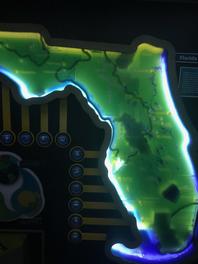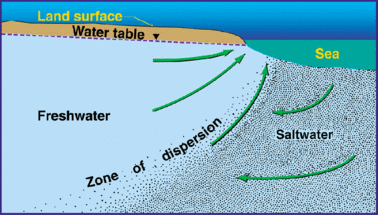Saltwater Intrusion
Getting fresh water to our homes is more complicated than many people realize. It seems amazing simple though, doesn’t it? I turn a handle, and water appears! Of course, we all know it’s not magic, but there are a lot of separate systems that all have to work together in order for it to happen.
First, we need the rain. It seems a bit counter-intuitive, but it is a part of this convoluted system. Then we need percolation, or the process of water seeping through the ground, to work so it filters that rain water and fills our aquifer. If the rain wasn’t able to seep into the aquifer, our main source of fresh water wouldn’t exist. Then we come to man-made technology - wells. We need our wells to work as they pump that water up out of the aquifer and send it to our homes for us to use every day.
With each step that is added, there is the chance of a problem occurring with our water. Some of the first issues people may think of are wells not working, pipes breaking, or the possibility of a drought. While these are all valid issues, there is also a lesser-known threat to our fresh water: saltwater intrusion.

Map of areas of saltwater intrusion around Florida.
Saltwater intrusion is when saltwater enters the aquifer, leaving less space for fresh water to be stored. Normally, freshwater in the aquifer moves toward the sea due to the elevation change (naturally flowing downhill), which keeps the saltwater from the ocean from moving too far into the aquifer itself. As you can see from the figure here, there is usually a line between the two water sources where there is some mixing of salt and fresh water, but they are kept fairly well separated.

Normal ground-water separation (USGS): U.S. Geological Survey Water-Supply Paper 1613-C, p. 1-12
When we pump fresh water out of the ground, it decreases that movement toward the ocean, and the saltwater is able to move further into the freshwater zone, in some extreme cases completely filling the area. Now if you imagine filling a glass of water to drink and discovering it was saltwater, you can see how much of a problem this could cause.
So why am I telling you this? Did I just want to ruin your day with bad news? No, of course not! Luckily, this is a problem that we can prevent, especially if everyone does their part. Performing simple acts to conserve water everyday helps to keep plenty of fresh water in the aquifer so the saltwater can’t displace it. Here are a few things you can do in your daily life to help avoid saltwater intrusion:
1. Turn off the water when brushing your teeth.
2. Limit your shower to about 5 minutes, or take a bath instead!
3. Wash your dishes in a full dishwasher.
4. Wash fruits and vegetables in a bowl of water instead of under running water.
5. Start a compost pile for food scraps instead of using the garbage disposal.
Small changes lead to big a difference over time, so join us in our quest to limit saltwater intrusion!